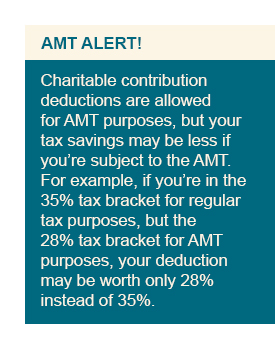Make your charitable giving count in 2018
 Giving to charity can provide not only large tax deductions, but also the satisfaction of doing good. On top of that, it’s one of the most flexible tax planning tools because you can control the timing to best meet your needs. Well-planned gifts also can save estate tax while allowing you to take care of your heirs in the manner you choose. But you must keep in mind various limits that could reduce the tax benefits of your donations.
Giving to charity can provide not only large tax deductions, but also the satisfaction of doing good. On top of that, it’s one of the most flexible tax planning tools because you can control the timing to best meet your needs. Well-planned gifts also can save estate tax while allowing you to take care of your heirs in the manner you choose. But you must keep in mind various limits that could reduce the tax benefits of your donations.
Also, remember that the Tax Cuts and Jobs Act (TCJA) has essentially doubled the standard deduction and limited or eliminated many itemized deductions (other than the charitable deduction) for 2018 through 2025. As a result, for 2018 some taxpayers who typically have itemized in the past may be better off taking the standard deduction — in which case they won't get a federal income tax benefit from charitable gifts. If you're such a taxpayer, you might benefit from “bunching” donations into alternating years. (See the Case Study “Bunching” charitable donations can provide tax savings.") But also be aware that tax legislation has been proposed that would allow nonitemizers to deduct charitable donations. Check with your tax advisor for the latest information.
To ensure you understand the tax consequences of your donations and can maximize any benefits, discuss with your tax advisor which assets to give and the best ways to give them.
Cash donations
Outright gifts of cash (which include donations made via check, credit card and payroll deduction) are the easiest. The key is to substantiate them. To be deductible, cash donations must be:
- Supported by a canceled check, credit card receipt or written communication from the charity if they’re under $250, or
- Substantiated by the charity if they’re $250 or more.
New! Deductions for cash gifts to public charities can’t exceed 60% of your adjusted gross income (AGI). Before the TCJA, the limit was 50%. Proposed legislation, however, could remove AGI-based charitable deduction limits. Check with your tax advisor for the latest information. For now, the AGI limit remains at 30% for cash donations to nonoperating private foundations. Contributions exceeding the applicable AGI limit can be carried forward for up to five years.
Stock donations
 Appreciated publicly traded stock you’ve held more than one year is long-term capital gains property, which can make one of the best charitable gifts. Why? Because you can deduct the current fair market value and avoid the capital gains tax you’d pay if you sold the property.
Appreciated publicly traded stock you’ve held more than one year is long-term capital gains property, which can make one of the best charitable gifts. Why? Because you can deduct the current fair market value and avoid the capital gains tax you’d pay if you sold the property.
Donations of long-term capital gains property are subject to tighter deduction limits — 30% of AGI for gifts to public charities, 20% for gifts to nonoperating private foundations. Again, proposed legislation could remove these limits. In certain, although limited, circumstances it may be better to deduct your tax basis (generally the amount paid for the stock) rather than the fair market value, because it allows you to take advantage of the higher AGI limits that apply to donations of cash and ordinary-income property (such as stock held one year or less).
Don’t donate stock that’s worth less than your basis. Instead, sell the stock so you can deduct the loss and then donate the cash proceeds to charity.
IRA donations
Taxpayers age 70½ or older are allowed to make direct contributions from their IRA to qualified charitable organizations, up to $100,000 per tax year. A charitable deduction can't be claimed for the contributions. But the amounts aren’t deemed taxable income and can be used to satisfy an IRA owner’s required minimum distribution. A direct contribution might be tax-smart if you won’t benefit from the charitable deduction.
To take advantage of the exclusion from income for IRA contributions to charity on your 2018 tax return, you’ll need to arrange a direct transfer by the IRA trustee to an eligible charity by Dec. 31, 2018. Donor-advised funds and supporting organizations aren’t eligible recipients.
Other types of donations
Gifts of cash are simple and gifts of stock can be tax-smart, but many taxpayers make other types of donations, such as vehicles, collectibles, services and even use of property. For an overview of the deductibility of various types of donations, see the Chart “What’s your donation deduction?”
Making gifts over time
If you don’t know which charities you want to benefit but you’d like to start making large contributions now, consider a private foundation. It offers you significant control over how your donations ultimately will be used.
You must comply with complex rules, however, which can make foundations expensive to run. Also, the AGI limits for deductibility of contributions to nonoperating foundations are lower. (See “Cash donations” and “Stock donations.”)
If you’d like to influence how your donations are spent but avoid a foundation’s down sides, consider a donor-advised fund (DAF). Many larger public charities offer them. Warning: To deduct your DAF contribution, you must obtain a written acknowledgment from the sponsoring organization that it has exclusive legal control over the assets contributed.
Charitable remainder trusts
To benefit a charity while helping ensure your own financial future, consider a charitable remainder trust (CRT):
- For a given term, the CRT pays an amount to you annually (some of which generally is taxable).
- At the term’s end, the CRT’s remaining assets pass to one or more charities.
- When you fund the CRT, you receive an income tax deduction for the present value
of the amount that will go to charity. - The property is removed from your estate.
A CRT also can help diversify your portfolio if you own non-income-producing assets that would generate a large capital gain if sold. Because a CRT is tax-exempt, it can sell the property without paying tax on the gain at the time of the sale. The CRT can then invest the proceeds in a variety of stocks and bonds.
You may owe capital gains tax when you receive the payments, but because the payments are spread over time, much of the liability will be deferred. Plus, only a portion of each payment will be attributable to capital gains; some may be considered tax-free return of principal. This may help you reduce or avoid exposure to the top 20% long-term capital gains tax rate or the NIIT. (See the Case Study "A CRT can reduce single-stock exposure risk.")
You can name someone other than yourself as income beneficiary or fund the CRT at your death, but the tax consequences will be different.
Charitable lead trusts
To benefit charity while transferring assets to loved ones at a reduced tax cost, consider a charitable lead trust (CLT):
- For a given term, the CLT pays an amount to one or more charities.
- At the term’s end, the CLT’s remaining assets pass to one or more loved ones you name as remainder beneficiaries.
- When you fund the CLT, you make a taxable gift equal to the present value of the amount that will go to the remainder beneficiaries.
- The property is removed from your estate.
For gift tax purposes, the remainder interest is determined assuming that the trust assets will grow at the Section 7520 rate. The lower the Sec. 7520 rate, the smaller the remainder interest and the lower the possible gift tax — or the less of your lifetime gift tax exemption you’ll have to use up. If the trust’s earnings outperform the Sec. 7520 rate, the excess earnings will be transferred to the remainder beneficiaries tax-free.
Because the Sec. 7520 rate currently is still fairly low but has been gradually rising with other interest rates, now may be a good time to lock in a relatively low rate while still available and take the chance that your actual return will outperform it. Keep in mind, however, that the increased gift and estate tax exemption may reduce the tax benefits of a CLT, depending on your specific situation. (See the Chart “Transfer tax exemptions and rates.”)
You can name yourself as the remainder beneficiary or fund the CLT at your death, but the tax consequence will be different.
Qualified charities
Before you donate, it’s critical to make sure the charity you’re considering is indeed a qualified charity — that it’s eligible to receive tax-deductible contributions.
The IRS’s online search tool, Tax Exempt Organization Search, can help you more easily find out whether an organization is eligible to receive tax-deductible charitable contributions. You can access the tool at https://apps.irs.gov/app/eos/. According to the IRS, you may rely on this list in determining deductibility of your contributions.
Also, don’t forget that political donations aren’t deductible.



